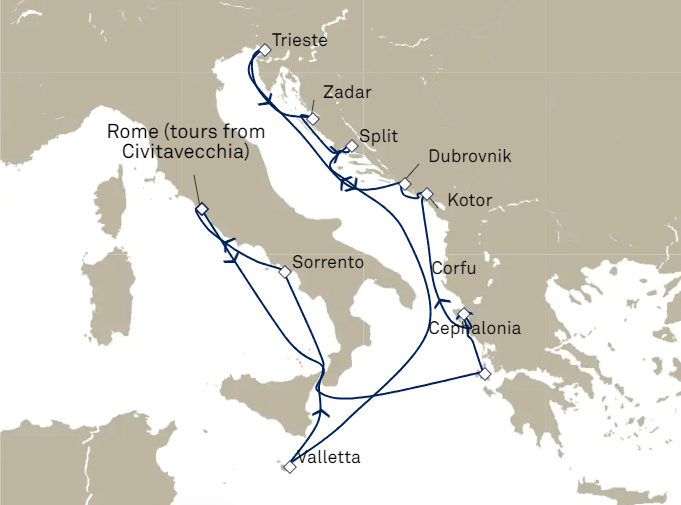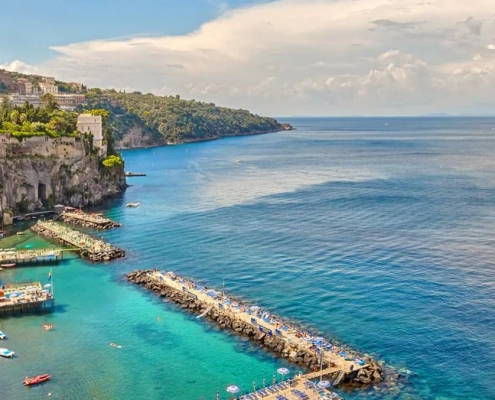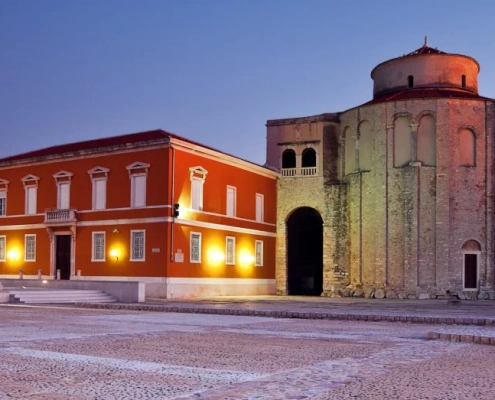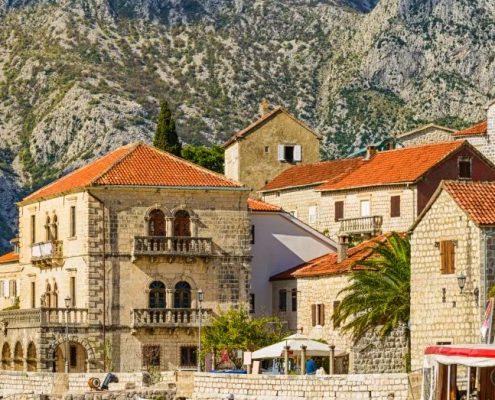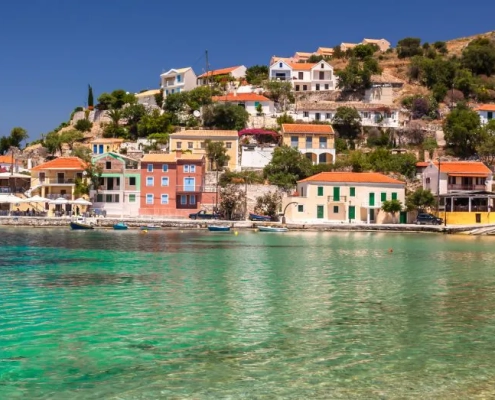Jun 4, 2024
Arrives Early morning
Departs Early evening
Zadar is a historic place, with Roman ruins and medieval churches to explore. Meanwhile, the cosmopolitan cafés and restaurants are great places to relax and enjoy the town’s distinct ambiance.
Zadar port guide.
Situated about halfway up the coast of Croatia, Zadar is as ideally located as it is charming. Both the Romans and the Venetians have laid claim to the city in the past, and the influence of both can be seen throughout Zadar today, specifically in its architecture.
If you have an interest in European history, you’ll find plenty to keep you enthralled. If you are in search of delicious and unique local food, the sprawling restaurant scene won’t disappoint. If national parks brimming with tranquil natural scenery are your idea of heaven, Zadar offers many within easy reach.
Top landmarks and sights in Zadar.
Zadar is home to a number of fascinating historic sites, and Kalelarga – which translates to long street – in the Old Town is widely considered the most important. Kalelarga dates back more than 2,000 years to the time of the Roman Emperor Augustus, and it has long been a hub of activity in Zadar. In addition to plenty of shops and cafés, Kalelarga is home to St. Anastasia’s Cathedral, built in the 12th and 13th centuries, and St. Donatus’s Church, with origins in the 9th century.
Adjacent to St. Donatus’s Church, you’ll find what’s left of the ancient Roman Forum, which was built between the 1st century BC and 3rd century AD. Take endless photos of the ruins of colonnades, temples, and an altar depicting figures such as Jupiter, Ammon, and Medusa.
Another more recent structure worth a visit is the Land Gate. Constructed in 1543, this was once the main entrance into Zadar, and today it acts as a grand portal into a world of rich Mediterranean history, culture, and cuisine. Note the central winged lion statue of St. Mark, which acts as a reminder of Venetian rule here.
Things to do in Zadar.
In addition to an array of ancient historical monuments, this picturesque patch on the Adriatic coast boasts a whole host of other things to see and do. In Zadar, you’re in easy reach of picture-perfect beaches, vibrant national parks, and some incredible food, to name just a handful of your options.
You could perhaps spend an hour or so in the Museum of Ancient Glass learning more about the ancient Roman method of creating glass structures and art. Watch as today’s glassblowers create replicas of Romanesque pieces, and make the most of an opportunity to have a go yourself.
For a more active experience, you could head to Paklenica National Park in Starigrad, which is just over an hour’s drive out east. This UNESCO World Biosphere Reserve is a remarkable spot filled with natural beauty at every turn, from the blue hues of sparkling lakes and cascading waterfalls to the varied wildlife. Take a gentle stroll, go for an invigorating, fast-paced hike, or even find opportunities for something a little more adrenaline filled, like climbing, rafting, or mountain biking.
Another option is to simply take life at a slower pace in the center of Zadar. Absorb the centuries of history that surround you as you meander along the city streets, or perhaps along the seafront promenade, stopping at cafés, parks, or magnificent viewpoints.
Eating and drinking near Zadar.
Zadar, like many of the cities on the scenic Dalmatian Coast, brings opportunities to sample all sorts of Croatian cuisine or international favorites, if you’d prefer.
Peka, for example, is a hearty, slow-cooked stew, usually made with meat and potatoes. In Zadar, however, it’s prepared with octopus, wine, and plenty of garlic. Slow-cooked lamb in flavorsome herbs and locally sourced tuna are other dishes seen on menus throughout the city.
Do as the locals do and perhaps wash down rich, comfort foods like this with a glass of wine. North of Zadar, Kraljevski Vinogradi, a vineyard, delivers beautiful bottles year after year. Or, if you have more of a sweet tooth, perhaps sample the local cherry liqueur – Maraschino – with soda or even just a little ice.
Two delicious Croatian desserts worth a try are madjarica, which is made with light sponge cake and chocolate layers, and orehnjača, a sponge roll with a sweet nut paste.
Shopping in Zadar.
When it comes to shopping for souvenirs or trinkets and treats in Zadar, the Old Town has a bounty of boutiques and market stalls. You could pick up locally made handicrafts, jewelry, art, and more from one of the many shops on Kalelarga.
For high-end gifts, perhaps visit the Supernova mall, home to a range of more mainstream clothing, footwear, jewelry, and perfume shops. Or, for a closer look into Croatian life, you could head to Zadar’s main market, known to locals as Pijaca. Here, you can browse or shop for all manner of foods, from fresh fruit and vegetables, cheese, and fish to spices and olive oil.
Getting around: Zadar transport.
Large ships, including the four Queens, dock in the cruise port at Gaženica that was opened in 2019. Located around 2.5 miles from the main center of Zadar, you’ll usually be offered a transfer.
In Zadar itself, you’ll see hardly any motor vehicles because the city is walkable. If you are looking to travel further afield, there are bus services, including those run by Liburnija, offering transport from the Old Town to the main coach and train stations in the surrounding areas.
Zadar port facilities.
Gaženica cruise port was voted the best in the world in 2019 at Hamburg’s Seatrade Cruise Awards. Its two-story passenger terminal offers a variety of helpful facilities, including restrooms, ATMs, currency exchange services, and tourist information.
Top tips for Zadar.
Currency.
As of January 2023, Croatia – including Zadar – has moved over to the euro from its previous currency, the Croatian kuna. While cards are widely accepted throughout the city, it’s advisable to carry some cash to use if you’ll be buying goods in markets and small shops or cafés. You’ll find ATMs throughout Zadar, and you can also purchase euros on board your ship.
Tipping.
Tipping in restaurants and cafés in Croatia is widely practiced but not mandatory. Somewhere between 10% and 20% of your bill is appropriate. Be aware, however, that some restaurants may already include a service charge in the bill.
Weather.
The warmest months in Zadar are July and August when temperatures reach an average of 77°F. The winter months of December, January, and February, on the other hand, see temperatures of roughly 45–48°F. November and December are when you’ll find the most rainfall, and July sees the least.



